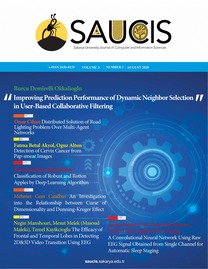An Investigation into the Relationship between Curse of Dimensionality and Dunning-Kruger Effect
Boyutun Laneti ve Dunning-Kruger Etkisi Arasındaki İlişkinin İncelenmesi
___
[1] S. Finger, Origins of neuroscience: a history of explorations into brain function. Oxford University Press, USA, 2001.[2] J. Ward, The student's guide to cognitive neuroscience. Psychology Press, 2015.
[3] P. Dayan and F. A. Laurence,” Theoretical neuroscience: computational and mathematical modeling of neural systems”, Journal of Cognitive Neuroscience, vol.15, no.1, pp.154-155.
[4] T. C. Napier, J. C. Corvol, A. A. Grace, J.D. Roitman, J. Rowe, J., V. Voon and A. P. Strafella,” Linking neuroscience with modern concepts of impulse control disorders in Parkinson's disease”, Movement Disorders, vol.30, pp.141-149, 2015.
[5] M. Filippi, fMRI techniques and protocols. Humana press, 2016.
[6] A. Poldrack Russell, “The role of fMRI in cognitive neuroscience: where do we stand?”, Current opinion in neurobiology, 18223-227, 2008.
[7] U. Goswami, “Neuroscience, education and special education”, British Journal of Special Education, vol.31, pp.175-183, 2004.
[8] Y. Immordino, M. Helen , A. Damasio, "We feel, therefore we learn: The relevance of affective and social neuroscience to education", Mind, brain, and education, vol.1, pp. 3-10, 2007.
[9] B. Aberšek, Cognitive science in education and alternative teaching strategies. Cambridge Scholars Publishing, 2017.
[10] B. Sung, N. J. Wilson, J. H. Yun, and E. J. LEE, “What can neuroscience offer marketing research?”, Asia Pacific Journal of Marketing and Logistics, pp. 4-23, 2019.
[11] S. Ullman, “Using neuroscience to develop artificial intelligence”, Science, vol. 363, no. 6428, pp. 692-693, 2019.
[12] G. Deco, E. T. Rolls, Computational neuroscience of vision. Oxford university press, 2007.
[13] D. Dunning,” The Dunning–Kruger effect: On being ignorant of one's own ignorance”, In Advances in experimental social psychology, vol.44, pp. 247-296, 2011.
[14] G. Pennycook, R. M. Ross, D. J. Koehler and J. A., Fugelsang,” Dunning–Kruger effects in reasoning: Theoretical implications of the failure to recognize incompetence”, Psychonomic Bulletin & Review, vol.24, no.6, pp. 1774-1784, 2017.
[15] N. Altman, M. Krzywinski, ”The curse (s) of dimensionality”, Nat Methods, vol.15, pp. 399- 400, 2018.
[16] V. Zelenyuk, “Aggregation of inputs and outputs prior to Data Envelopment Analysis under big data”, European Journal of Operational Research, vol.282, no.1, pp. 172-187, 2020.
[17] M. Ramscar, P. Hendrix, C. Shaoul, P. Milin, H. Baayen, “The myth of cognitive decline: Non ‐Topics in cognitive science linear dynamics of lifelong learning”, , vol.6, no.1, pp.5-42, 2014.
[18] Y. Wang, and V. Chiew, “On the cognitive process of human problem solving”, Cognitive systems research, vol.11, no.1, pp.81-92, 2010.
[19] H. Kuai, X. Zhang, Y. Yang, J.Chen, B. Shi, N. Zhong, “THINKING-LOOP: The Semantic Vector Driven Closed-Loop Model for Brain Computing”, IEEE Access, vol.8, pp.4273-4288, 2020.
[20] Y. Wang et al., “Brain-Inspired Systems: A Transdisciplinary Exploration on Cognitive Cybernetics, Humanity, and Systems Science Toward Autonomous Artificial Intelligence”, IEEE Systems, Man, and Cybernetics Magazine, vol. 6, no. 1, pp. 6-13, Jan. 2020
[21] R. Shivhare, A. K.Cherukuri, and J. Li, ,”Establishment of cognitive relations based on cognitive informatics”, Cognitive Computation, vol.9, no.5, pp.721-729, 2017.
[22] H. Faris, I. Aljarah and S. Mirjalili, Evolving radial basis function networks using moth–flame optimizer. In Handbook of neural computation, Academic Press, pp. 537-550, 2017.
[23] C. Zhang, H. Wei, L. Xie, Y. Shen, and K. Zhang, “Direct interval forecasting of wind speed using radial basis function neural networks in a multi-objective optimization framework”, Neurocomputing, vol. 205, pp.53-63, 2016.
[24] I.T. Jolliffe and J. Cadima, “Principal component analysis: a review and recent developments”, Philosophical Transactions of the Royal Society A: Mathematical, Physical and Engineering Sciences, vol.374, no.2065, 20150202, 2016.
[25] G. R. Naik, Advances in Principal Component Analysis: Research and Development. Springer, 2017.
[26] I. Craw, The aberdeen set of Psychological Image Collection at Stirling (PICS) database (PICS), URL: http://pics.psych.stir.ac.uk/zips/Aberdeen.zip [Accessed: 19-July-2020].
[27] N. Kriegeskorte,”Deep neural networks: a new framework for modeling biological vision and brain information processing”, Annual review of vision science, vol.1, pp.417-446, 2015.
[28] J. C. Hong, , M. Y. Hwang, , K. H. Tai and C. R. Tsai, ”An exploration of students’ science learning interest related to their cognitive anxiety, cognitive load, self-confidence and learning progress using inquiry-based learning with an iPad”, Research in Science Education, vol.47, no.6, pp.1193-1212, 2017.
- ISSN: 2636-8129
- Yayın Aralığı: Yılda 3 Sayı
- Başlangıç: 2018
Detection of Cervix Cancer from Pap-smear Images
An Investigation into the Relationship between Curse of Dimensionality and Dunning-Kruger Effect
Classification of Robust and Rotten Apples by Deep Learning Algorithm
The Efficacy of Frontal and Temporal Lobes in Detecting 2D&3D Video Transition Using EEG
Negin MANSHOURI, Mesut MELEK, Temel KAYIKCIOGLU
Distributed Solution of Road Lighting Problem Over Multi-Agent Networks
Improving Prediction Performance of Dynamic Neighbor Selection in User-Based Collaborative Filtering
Göksu Zekiye ÖZEN, Rayımbek SULTANOV, YUNUS ÖZEN, Zahide YILMAZ GÜNEŞ
